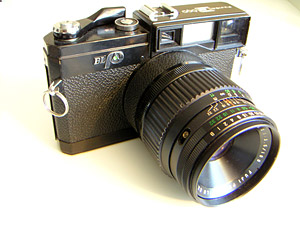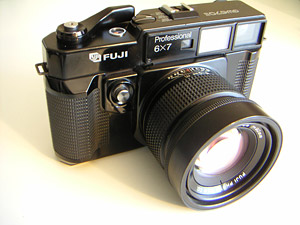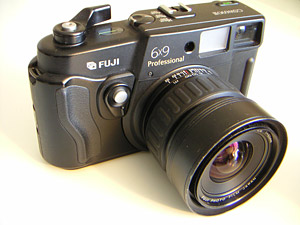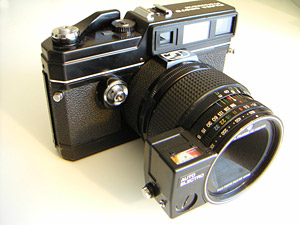The Fujica GW690 Professional and the nine similar models that followed it are leaf-shutter fixed-lens rangefinder cameras for 120/220 film that Fuji brought out as successors to its interchangeable-lens Fujica GL690 and GM670 Professional models.
In addition to the Fujica GW690 Professional and Fujica GSW690 Professional (the last to be called "Fujica"), the series includes the Fuji GW690II, GW670II, GSW690II, GW690III, GW680III, GW670III, GSW690III and GSW680III (all of them "Professional"); the entire series is treated within this article.[1]
Features (such as interchangeable film backs) normal among medium-format cameras of the time, and others (such as exposure meters) almost universal among cameras in general are missing in the GW690 and its successors, which look rather as if a black Leica M3 with a particularly large lens (perhaps 85mm f/1.8) had been made to a much larger scale.
The Fujica GW690 Professional was the first to be released, in November 1978. It is based on the GL690 — a leaf-shutter rangefinder camera for 6×9 exposures on 120 or 220 film — from which it differs most importantly in having a fixed lens.
The lens is an EBC Fujinon, 90mm f/3.5, with five elements in five groups (72mm filter thread). Reputedly it is sharper at large apertures than the 100mm lenses of the earlier cameras, but out-of-focus areas are not so pleasant.
The GW690 was priced at ¥143,500.
The right and (to a lesser extent) the left sides of the front of the camera are convex, forming the kind of grips that soon become very common on other cameras (and that often contain batteries) but were unusual at the time.[5] A switch on the top and next to the accessory shoe selects among short-roll 120 (four exposures) and regular 120 (eight) and 220 (sixteen); there is no longer provision for sheet film. The dimensions are 189(W)×119(H)×123(D)mm; it weighs 1430g, a saving of 300g from the GL690, mostly attributable to the lack of lens breechlock, curtain, and associated switchgear.
The Seiko #0 shutter lacks a B setting and instead only has T.[6]
The shutter seems curiously noisy for a leaf shutter; but in fact the noise is produced not by the shutter but instead by a device at the bottom of the camera that counts multiples of ten shots — up to 999, and then, like a car odometer, restarting at 000 — and is intended to remind the owner when shutter servicing is needed. Different people have different numbers for recommended servicing; Chatani says that the shutter was to have been guaranteed for 10,000 exposures.[7] What is certain is that this "odometer" can easily be tampered with (just like that of a car) or disconnected for quietness.
The rangefinder spot is round rather than rectangular. Instead of "mushroom" strap lugs, there are two loops for a strap on the left side of the camera (the side under the photographer's left hand).
The Fujica GSW690 Professional is a wider-angle version of the GW690. The lens is an EBC Fujinon SW 65mm f/5.6, with six elements in four groups (67mm filter thread). It weighs 1475g. It was released in March 1980, for ¥163,500.
This lens is widely thought to be optically identical to the 65mm f/5.6 lens available for the G690 series.
Released in June 1985, the Fuji GW690II Professional and Fuji GSW690II Professional are minor revisions to the GW690 and GSW690. The accessory shoe is now a hotshoe, the shutter release has a lock, the grip is checked rather than ribbed, and the strap lugs are conventionally one to each side, rather than both on one side.
The GW690II and GSW690II are ten and five grams heavier respectively than their predecessors.
The cameras were priced at ¥158,500 (GW690II) and ¥178,500 (GSW690II).
Released in December 1985, the Fuji GW670II Professional was Fuji's follow-up to the GM670 as 6×7 camera. It differs from the GW690II only in having a smaller film gate and different gearing and numbering for the film advance mechanism. It was priced at ¥163,500.
The Fuji GW690III Professional, Fuji GSW690III Professional, and Fuji GW670III Professional have redesigned exteriors that emphasize curves rather than right angles and have rubberized coatings. They also have a small spirit level embedded in the top in front of the wind lever (this level has a single axis, serving only to help balance the left and right), and push-button spool release.
Despite allegations in web forums, etc., of how these new cameras are "plasticky" compared with their 1985 predecessors, the GW690III, GSW690III and GW670III weigh 20, 30, and 15 grams more than their respective predecessors.[8]
The two 6×9 models were released in Japan in February 1992, at ¥179,000 (GW) and ¥197,000 (GSW). The 6×7 model was released in March 1992, for export only.
Fuji had brought out a (nominally) 6×8 camera in 1986, the GX680 professional studio SLR. Perhaps for the Japanese market only, it brought out 6×8 versions of these rangefinder cameras: the Fuji GW680III Professional and Fuji GSW680III Professional in March and November 1992 respectively. Like the 6×7 models, these differ from the 6×9 models only in having a smaller film gate and different gearing and numbering for the film advance mechanism: the dimensions and weights are the same as for the 6×9 models, and in Japan the prices were too.
In English
- The Japanese Historical Camera. 日本の歴史的カメラ (Nihon no rekishiteki kamera). 2nd ed. Tokyo: JCII Camera Museum, 2004. p. 184. The G690, included for its "odometer".
In Japanese
- Koyasu Yoshinobu (子安栄信). "Fuji Shashin Firumu no kamera no subete" (富士写真フィルムのカメラのすべて All the cameras of Fuji Photo Film). Kamera Rebyū: Kurashikku Kamera Senka (カメラレビュー クラシックカメラ専科) / Camera Review: All about Historical Cameras 44, December 1997. ISBN 4-257-13013-X. Tokushū: Fuji Shashin Firumu no kamera (特集:富士写真フィルムのカメラ, special issue on the cameras of Fuji Photo Film). Koyasu deals with these cameras on pp. 69–72.
- Nawa Hidetaka (那和秀峻). Meiki o tazunete: Sengo kokusan-kamera hiwa (名機を訪ねて:戦後国産カメラ秘話) / Revisiting renowned cameras. Tokyo: Nippon-kamera-sha, 2003. ISBN 4-8179-0011-3 Nawa devotes pp. 255–71 to the G690 and its successors.
In English:
- Manual (pdf format) for the GW670II, GW690II and GSW690II
- Evolutionary History of Fuji 6x7, 6x8 and 6x9 Rangefinders, by Dante Stella
- Fujica G690 and its successors at Robert Monaghan's Medium Format Photography Megasite, with much discussion. (The page at first appears to be about the G690 and its immediate successors, but in fact much of it is about the later, fixed-lens cameras.)
- The Fuji Rangefinder Pages (for these and other medium-format Fuji cameras)
- GW690III and GSW690III and GW670III by Michael Coates
- eBay prices for the 6×7 and 6×9 cameras on Dan Colucci's site
In French:
- Illustrated history of the G690 and successors, by Babar de St Cyr
- Medium format rangefinders by Daniel Herlent, scroll down for pictures of the GW670II, GSW680III and GW690III
- Fuji GW670 III at Sylvain Halgand's www.collection-appareils.fr
In Japanese:
- Fujica G690BL and GM670 at Minokan Film Camera Research Room
- GW690 and GSW690III at M Nishikawa's site
- GW690 at Beyoontavox
- GW690 at Field Cameraman Note

G690BL
1967 - G690/G690BL: This is the grandfather of all Fuji rangefinders.
The G690 (1967) is the earlier version. Black or chrome finishes with lenses to match.
The G690BL (1970) has a circular (rather than teardrop-shaped) darkslide knob and a BLP logo on the front. Black only. Otherwise identical to the G690, as far as I can tell. BL stands for "Breech Lock."
Interchangeable lenses; heavy die-cast frame; black-painted brass covers; 0.75x combined view/rangefinder (gold beamsplitted, fuzzy-edged gold rectangle on bluish field) with framelines for 100mm and 150mm lenses; field-compensating; 96% coverage at 1m, 92% at infinity. Available lenses are 65mm f/8, 100mm f/3.5 and 180mm f/5.6.
GM670
| Early 1970s - GL690 / GM670: Same as the G690BL but — slight redesign of viewfinder frame; — "hump" on lens mount (for the "G" logo); — mating suface for lens bayonet now anodized black, rather than chrome plated; — added front shutter release with cable release socket; — omitted darkslide warning in viewfinder; — omitted the "100mm" and "150mm" labels on the framelines. Frameline illuminator window now ribbed. Framelines improved; — changed eyepiece type to Nikon FE/FM/FA/F3 size and thread; and — changed normal strap lugs to Pentax-style mushroom lugs. Some lenses contemporaneous with these models have multicolored aperture rings and rubber focusing grips. An AE 100mm f/3.5 lens becomes available, as do 50mm f/5.6 , 65mm f/5.6 and 250mm f/5.6. I believe that the 65/5.6 is very close to the same lens as the one on the GSW cameras. All lenses are backward-compatible with older bodies. |
Mid-1970s - GW670 and GW690: In the mid 1970s, Fuji changed over its GL and GM series interchangeable-lens rangefinder 6x7s and 6x9s into the GW series. The first of these new cameras, the GW690 (also GW670), had the following differences from its predecessors:
|

GW670II
Mid-1980s - GW670II, GW690II, GSW690II: The next generation made the following changes: (1) checkered grip surfaces; (2) redesigned film selector (added short roll 120); (3) hot shoe in addition to body-mount synch terminal; (4) built-in sliding lens shade. The GSW690II added a 65mm f/5.6 Fujinon (probably similar to the older interchangeable lens).

GSW690III
Mid-1990s - GW670III, GW680II, GW690III, GSW680III, GSW690III: The next and last generation did not change much in terms of optics but made a lot of changes nonetheless:
— GW and GSW680III models are introduced in Japan (6x8 cm, 9 shots per 120 film) to resurrect the obsolete 3x4" format's proportions in a new camera.
— Totally new VF/RF mechanism. The older gold-coated beamsplitter system is replaced by a new vernier (Leica-style) hard-edged rectangular spot on an aluminized beamsplitter. The upshot is that brightness is increased but VF-RF spot contrast is reduced.
— Pushbutton loading means that pressing two small red buttons inside the film chamber releases the film spools.
— Redesigned back now has latch on the camera back, as opposed to a pull-down lever on camera bottom. Pressure plate is unchanged.
— Matte plastic covers with new, rounded proportions. Anatomical grip on front and back of right side.
— Bubble level on top of camera.
Not surprisingly, the III series sells for a lot more, even used. Discontinued.
Plastics: the urban myth of the Fuji RF: People constantly complain that the GW and later Fuji RFs (particularly the III series are "plastic." This is nonsense. The camera has a pretty hefty metal content, demonstrating that the camera has gradually evolved from the G690 rather than being a remake of it.
(1) The III series is not light. In fact, a GSW690III weighs about the same as a GW670II, which is only about a pound lighter than a G690 with a lens. The major weight savings appears to have come with the elimination of the interchangeable lens mount. If this camera had a plastic structure, you would expect it to be a lot lighter.
(2) The external parts are in fact plastic, but the frame is still die-cast and the back is stamped metal. The lens barrel is also metal (I can see that from some pinpoint finish marks...). This was the same situation with the GA645 - people think that because it has plastic covers, it must be plastic. Of course, plastic and rounded corners makes it feel "lighter..." Erwin Puts'"haptics" in action.
(3) You can see that the attachment screw locations for the covers have not changed one whit since the G690BL - telling me that this is probably the same or similar tooling for the main casting. I would tend to doubt that enough of any one model was made to justify the tooling costs for a complex body casting. These were never cheap cameras to buy new.
Why the funky "T" setting? I learned through some discussions with Greg Weber in relation to some Koni-Omega stuff that the "B" setting on many Copal-type shutters is activated by a pawl that can get bent if the shutter speeds are changed on a cocked lens (regardless of what the speed is and what it is being changed to). Fuji's T setting may be a response to that problem.
Bottom Line: Hard to lose with any of these.
http://www.dantestella.com/technical/gw.html


沒有留言:
張貼留言